Overview
How to get in and out of a car
If you have problems with mobility or balance, getting into a car may be difficult. It's easiest and safest to sit down in the car first, and then move your legs into the car after you're seated. And if the ground is slick or icy, this method is safer for everyone.
If it helps, move the front seat forward or backward. You can do this before or after you sit down, depending on your needs.Some people find that this makes it easier to get in and out of a car.
Back up to the door frame.
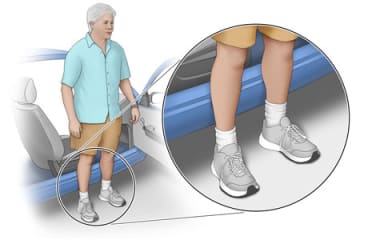
When you get to the open car door, turn around so that you're facing away from the car. Back up slowly until the backs of your legs touch the door frame.
Hold something stable.
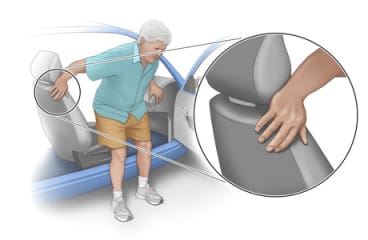
Reach back and hold on to something stable, such as the back of a seat or the dashboard. Don't use the open door or headrest for support. They might move.
Sit down slowly.

Slowly sit down so that you are sideways on the seat, facing out the door. Be careful not to hit your head on the top of the door frame.
Turn to face forward.
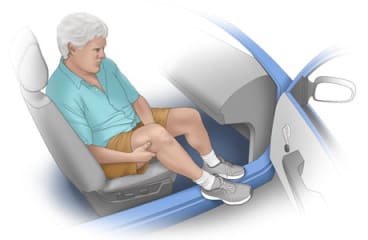
As you turn your body to face forward, lift your legs into the car one at a time. Use your hands to help lift your legs if you need to.
To get out of the front seat, do the same steps in reverse.
For a knee injury, try riding in the back seat.

Instead of lifting both legs in and facing forward after you sit, slide back on the seat so that your injured knee is resting across the seat. Try to position yourself so that you can wear a seatbelt comfortably.
If your car seat has fabric upholstery, you might find that it's hard to slide across it. Try covering the seat with something to make it easier to slide on, like a piece of plastic or vinyl. Make sure it doesn't get in the way of your seat belt.
If you still have trouble, ask your physical therapist or occupational therapist to show you the best way to get in and out of a car. They can also tell you about tools that can help you get in and out more easily.
Devices that can help
There are a number of devices that can make getting in and out of the car easier. You can find them at medical supply or auto stores or online.
And if you don't already have one, think about getting a disabled parking permit. Your doctor can help you. The doctor will fill out a form that you can take to the local licensing or tax office. These permits may be permanent or temporary.
Grab bar and door strap
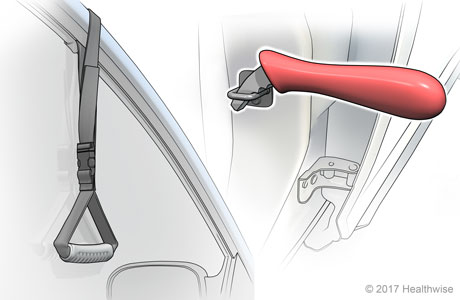
There are several types of handholds that can be added to the frame of your car door or beside the door. They give you something to hold on to as you get in and out of the car seat.
Swivel seat
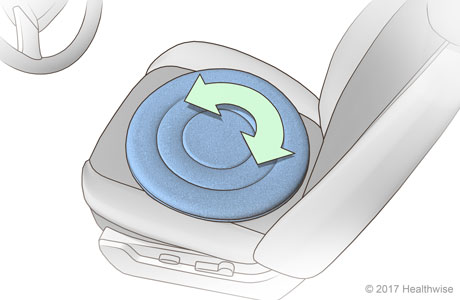
A swivel seat is like a lazy Susan or a turntable. You sit down facing sideways and then use it to turn forward as you pull your legs in.
Seat belt extender
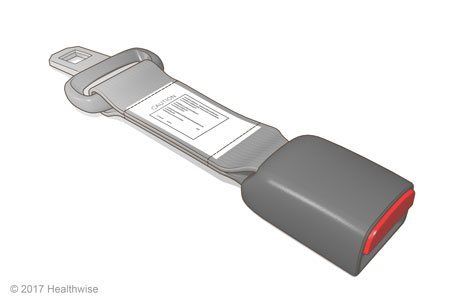
If you have a hard time with a normal seat belt, an extension may help you find and reach the end of the belt more easily.
Related Information
Credits
Current as of: July 24, 2025
Author: Ignite Healthwise, LLC Staff
Clinical Review Board
All Ignite Healthwise, LLC education is reviewed by a team that includes physicians, nurses, advanced practitioners, registered dieticians, and other healthcare professionals.
Current as of: July 24, 2025
Author: Ignite Healthwise, LLC Staff
Clinical Review Board
All Ignite Healthwise, LLC education is reviewed by a team that includes physicians, nurses, advanced practitioners, registered dieticians, and other healthcare professionals.


